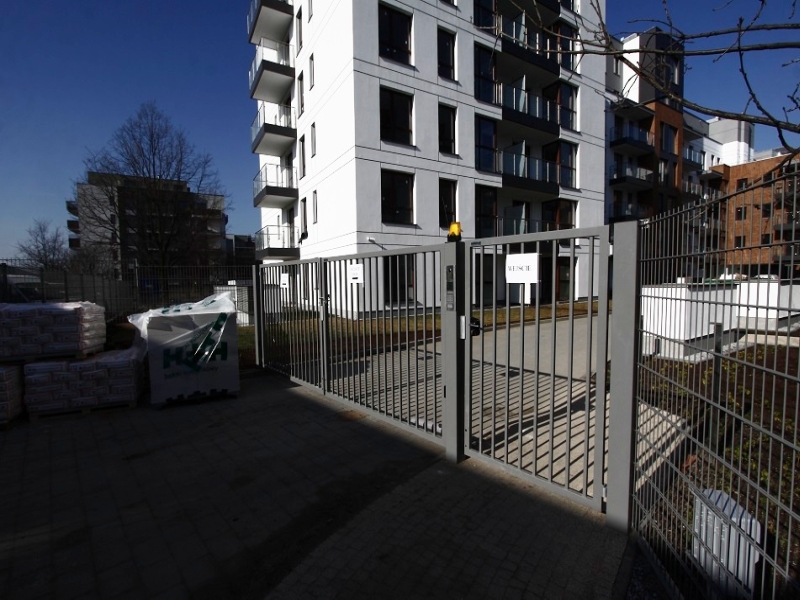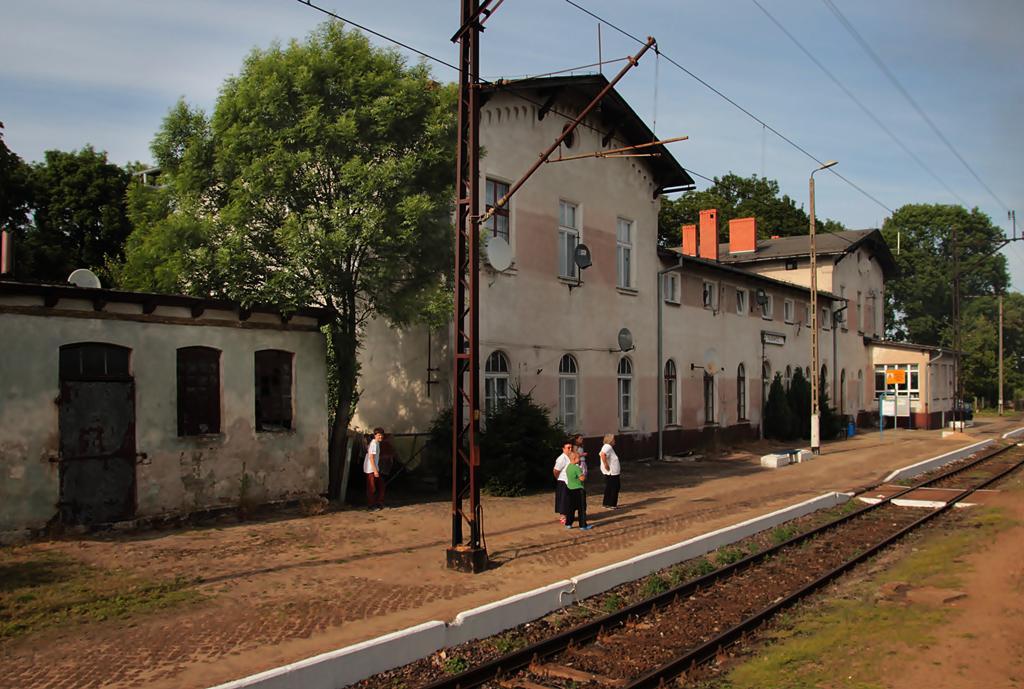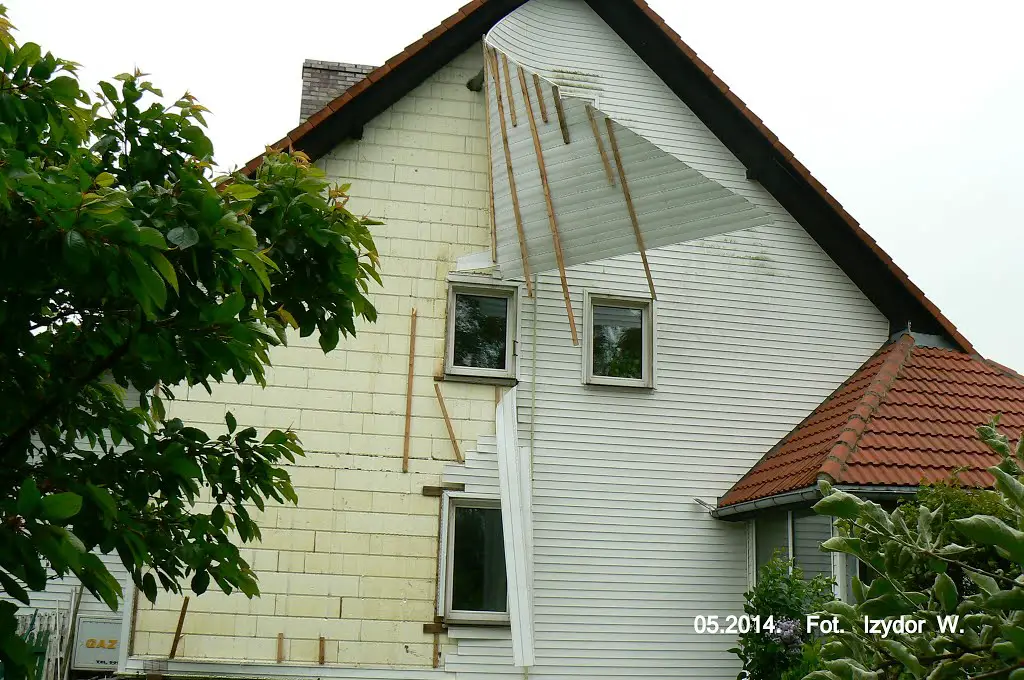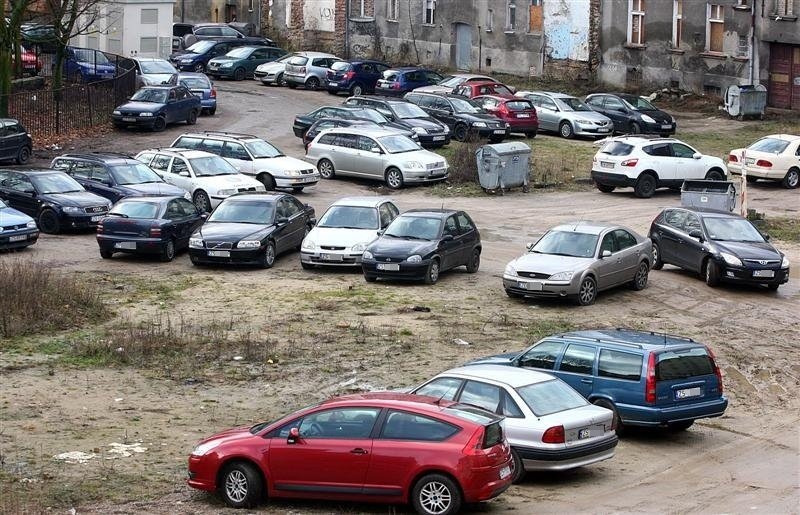|
|
Post by Bonobo on Apr 6, 2021 16:11:28 GMT 1
He also dislikes fenced housing estates  and poor railway stations in the countryside  and vinyl siding covering houses  and random car parks.  and dog poo on the ground. and garbage bags in front on houses That is all what he mentioned. Read the translated article www.polityka.pl/tygodnikpolityka/mojemiasto/1507608,1,15-najbrzydszych-rzeczy-w-polsce.read?src=mt
Some people save their withered beauty with plastic treatments. And the natural face turns into a grotesque, artificial, otherwise beautiful face. Polish towns and villages have undergone a similar metamorphosis in the last two decades. The ugliness of the People's Republic of Poland was unpretentious. Shabby plasters, dirty and crooked pavements, primitive architecture, trampled lawns, drab clothes, dismal shop windows, unsightly furniture with a wall unit at the forefront. True, it was nasty, but no one tried to pretend otherwise. Some of this horror has survived to this day, mainly in construction, which cannot be simply swept under the rug. The pseudo-modern blocks, squeezed into the historic buildings of numerous old towns, are constantly haunted by single-family houses on a regular square plan (about 1.3 million of them were erected in the country after World War II),
However, a lot has changed. Often for the better indeed. Everyone will admit that our cities and towns, our apartments and offices, and finally we ourselves look prettier and neater than 20, 30 years ago. Equally often, however, these are only apparent changes for the better. Gray-colored PDT suits have replaced white boots, embroidered jeans or colorful blouses from Chinese imports, beating the eyes away with sequined Versace or Dolce & Gabbana inscriptions. The trampled lawns have turned into lawns that grow vigorously (nutrients!), But all covered with dog poop, which can only be seen up close. Empty shop windows have replaced shop windows with painfully overloaded, cracked paving slabs and asphalt surfaces - Baum's cube, high-gloss furniture - tables and cabinets pretending to be made only of natural wooden boards,
Sometimes you can still encounter the traditional, old, homely dirt, mess, stench here and there. But the ugliness of the new generation covers this old as a layer of fresh paint with each passing year more and more accurately. For contemporary Polish ugliness has changed the costume from coarse local to colorful, pseudo-European. From natural ugliness to kitsch and a caricature of beauty. It simulates wealth, beauty, modernity, closeness to the great world. It is more dangerous, because it is unnatural, because it pretends to be something it is not, and thus weakens our vigilance. And those who produce it are convinced that they do themselves and others nicely. Even vandalism is more progressive; In place of the broken glass in the staircases, sprayed inscriptions have appeared, and the rubbish, once scattered chaotically, lies in tied plastic bags.
The list was not easy to compose, but the "dirty fifteen" (the order depends on how strong our eyes are) would look like this:
1. Garbage bags
Usually black or blue. With a capacity of 35 to 240 l. You can come across them absolutely everywhere: in roadside ditches, in forests and gardens, at the edges of fields and housing estates, even in lakes. And to think that in the early days they were supposed to hygienise and organize waste disposal. Today they have become a symbol of a totally littered Poland. They scattered throughout the land. There is not enough space for them in 700 official landfills (plus 70,000 illegal landfills), because more than 90 percent of landfills are stored here. rubbish, while in the European Union only 48 percent. (in some countries below 30%). There, it has long been convinced that rubbish is worth incinerating or recycling and composting. But France has 128 waste incinerators and Poland has one. In Denmark, 54% of fuel is burned. rubbish, with us - almost nothing. Likewise with recycling. We are responsible for 5 percent. waste, in Norway - 80 percent. That is why we are doomed to the ubiquitous bags for now.
But there is a light of purity in this garbage tunnel. This is a revolutionary, in our terms, draft of a new law, under which municipalities will become the owners of rubbish. They will collect a new, small tax from their residents and for the money obtained in this way they will take care of the waste management themselves. Throwing them into the forest or a roadside ditch will not make sense. So far, this system has been introduced experimentally in several municipalities and the results are - by Polish standards - surprising. In Pszczyna, the amount of segregated waste increased 30 times, and the amount of garbage collected - by one third (it was this third that had landed in illegal landfills so far). Not to mention the fact that it got cleaner around.
2. Urban disorder
The landscape of Polish towns and villages is the result of combining everything with everything. Perhaps it works well in fashion, but definitely not in urban planning. We have no order, composition, harmony, good taste, we have a kociokwik of forms, colors, ornaments and styles . - There are new buildings erected by independent developers. This architecture is aggressive, scaled up and completely ignoring its surroundings - explained POLITYKA, editor-in-chief of the monthly "Urbanista", Janusz Korzeń. Spatial development plans (often too liberal towards investors), covering only 15 percent. the surface of our cities, they only deepen this chaos. We won't get out of this aesthetic swamp soon.
3. Scribbles
Wrongly called graffiti. We are talking not about paintings with ambitions, but about hastily made inscriptions and daubs in every possible place. A few years ago, similar practices decided to radically combat Toulouse in France. 50 employees were employed, who painted over 125,000 in the first year of work. sq m of wall scribbles. And with us, from time to time, individual cities take similar actions. In 2007, in Krakow, 2 thousand. subtitles, similarly in Lodz. But the hydras keep growing their heads, pseudograffiti scare even from the walls of churches or offices.
Internet user krzys22 wrote on his blog 863 inscriptions that appeared on the walls. Unfortunately, witty and intelligent people like "This America will get you," belong to the vast minority. If street entries were taken seriously, it would turn out that all Polish footballers and policemen are homosexuals of Jewish nationality. These genealogical and sexual discoveries are most visible in cities with conflicting football clubs, such as Warsaw (Legia, Polonia), Łódź (ŁKS, Widzew), and Kraków (Wisła, Cracovia). There, even ten teams from Toulouse would do nothing.
4. Ads
Billboards and frontlights, backlights and citylights, scrolls and banners. We already have over 100,000 in Poland. the so-called outdoor advertising media and millions of private, smaller or larger, advertising and information boards, signs. All of them tightly sealed the Polish cities on the ground floor level. And new ones are constantly coming, especially the biggest ones. The number of advertising boards with an area of 48 sq m has increased by 300 percent in the last five years, and those with an area of 34 sq m by even 400 percent.
In the fight against this colorful mosaic, there is the first success - a new ordinance of the Minister of Infrastructure, which should substantially limit the number of large advertising sheets tightly covering the entire facades of large buildings. However, this is still very little compared to the spatial restrictions in force in other countries. In France, it is forbidden to place advertisements outside built-up areas, in green areas and historical buildings, and elsewhere - it is also not easy to obtain permission. Anyway, maybe it's not worth fighting with us? In recent studies conducted by GfK Polonia, as much as 40 percent. compatriots decided that thanks to large-format advertisements, the city is more beautiful (!), and as much as 83 percent. advertisements on buildings are not annoying.
In 2007, the Austrian artist Gregor Graf realized an interesting project: using a computer program, he cleaned the pictures of the center of Warsaw from all advertisements and signs. The capital immediately catched off!
5. Kolejowisko
Two years ago, Gazeta Wyborcza published a ranking of 23 largest Polish railway stations, with a maximum of 100 points to be scored. Well, the winner (Białystok) took only 71 of them, and the weakest in the competition - only 30 (Eastern Warsaw). And no wonder, because most of the places in Poland for getting on and off trains are real curiosities. And dirty.
But this is not only a problem of railway stations, but of all the property that PKP has at its disposal. And it is gigantic: 106 thousand. hectares, 2.7 thous. railway station buildings, of which nearly a thousand are still active, tracks, sidings, signal boxes, etc. It is like an aesthetic state within a state, ready set design for a catastrophic film. The quintessence of Polish muck: shabby plaster, broken windows, collapsing hovel, rubbish, dirt, mess, spray-smeared trains. It is true that the areas belonging to PKP were not oases of beauty, aesthetics and cleanliness also in the People's Republic of Poland. But it was their spread that disappeared in the general spread of the whole country. Today, railway lichens are especially visible against the background of more beautiful surroundings: villa gardens with nicely trimmed grass along the tracks or bright skyscrapers in the immediate vicinity of stations.
Some time ago, this nasty stuff was divided among different keepers. PKP Branch Railway Stations is responsible for order at 83 largest stations, for the remaining 900 stations - Real Estate Management Departments, for platforms, railway tracks and their immediate vicinity - PKP Polskie Linie Kolejowe, for freight cars and railway sidings - PKP Cargo, and for passenger carriages - PKP Intercity etc. Not much has changed, but at least the responsibility spread.
6. Dog poop
Another permanent element of the landscape. In the countryside, dog droppings somehow disappear in tall grasses and forests, or blend in with the background of dirty yards. In cities, however, it is difficult to escape from the view. According to various estimates, we have from 6 to 10 million dogs in Poland.
Admittedly, various cities are taking ambitious actions to persuade citizens to use shovels and plastic bags (often distributed free of charge), but so far with poor results. The sight of a cleaning lady after her dachshund is rather surprising, and the sight of a huge shepherd dog leaving behind a huge stinking mountain in the middle of the pavement - at most a grimace of disgust.
Fortunately, a movement of civic discord is slowly waking up in obsessed (please forgive the vocabulary, but this is what it looks like) Polish cities. And all the appalled unite, for example, around such websites as: polska.blogspot.com. Its creator asked the fundamental question "why am I living in a closet?", And then points out and bluntly. He called for a new "fellow countrymen" on this issue, and even announced his own highly emotional prevention program, consisting of five stages. Let's just quote the beginning of Stage One: "Whenever you see a m*th*rf**k*r shitting his doggie in a public place, point him out politely."
7. Fencing
Five years ago, there were about 200 gated estates, smaller or larger, in Warsaw. Today there are already 400. In other cities less, but also a lot. The scale of separating apartment blocks from the surrounding area by walls, fences and nets places us at the forefront, next to the USA, Russia and some South American countries (we have no equal in the EU). The example most often cited is the capital's Marina Mokotów, where 32 ha were fenced off in the center of the city, and individual houses were also fenced off within the estate! So it can be said that people live there safely behind double barriers. Because it is security, along with prestige, the most common arguments for "for" by the residents themselves. And it can be assumed that the process will progress, because as much as 75 percent. Poles declare that they like this form of organization of the nearest area.
While city fences, although they are something unnatural, mostly maintain aesthetic standards (metal and wooden fences, less often hedges that require time and care), the native province has succumbed to the enchantment of concrete fences. Actually, the charm of the price (about PLN 50 per running meter including the arrangement), much lower than brick-steel fences (PLN 350), brick-wooden fences (PLN 250), and even ordinary mesh (about PLN 70). In this way, exceptionally hideous concrete panels with cheesy embossing, ornaments, balusters, once found at most around cemeteries, today divide Poland along and across into small private plots. Pretending to be solid walls, they are a bit of luxury for the poor.
ADVERTISEMENT
8. Bazaars and markets
Brazilian favelas are the pinnacle of urban order and harmony next to Polish bazaars and marketplaces. Our traders show extraordinary inventiveness in architectural solutions, in which corrugated sheets harmonize wonderfully with unplastered blocks, unplaned boards and many other, sometimes surprising, building materials. At the marketplaces, you can trace the entire history of Polish small trade in the last two decades, from inverted crates, through camp beds, then the so-called jaws, decommissioned caravans to cramped, but own stationary sheds. In the mid-1990s, about 150,000 people lived in bazaar trade in Poland. people. Today there are fewer traders, as well as the bazaars themselves. There is also no longer one of the largest and certainly the ugliest market on our continent - the Europe Fair.
One observant internet user posted on his blog three photos of the same square, in 1894, 1979 and 2010, respectively. On the first one a market crowd is swirling in the mud. On the second side, a well-kept, large pavilion of the Społem department store with a large, empty lawn in the square. And the last photo does not differ much from the one from the 19th century. The same chaos, dirt, mud and crowd, but the carts were replaced with old delivery vans.
9. Large-panel facades
The last ten years has been the time of intensive thermal insulation of the so-called big plate. And along with thermal insulation - putting new plaster facades. And only here opens the field for artistically unused CEOs of housing co-operatives. As a long and wide country, we have huge pastel undulations fighting for primacy with great pastel geometric abstraction. Diamonds compete with streaks, triangles with gentle curves. In the high-rise buildings of Krakow's Prokocim, green, blue, red and yellow are adjacent to each other inconsistently, but abundantly. In Zaspa in Gdańsk, houses were painted with Christmas trees, and in the Huby estate in Wrocław - with red roofs with chimneys. There are hundreds of similar examples. Do we know who is to blame for this paranoid fashion? Perhaps the Sobieski Hotel in Warsaw, which was probably the first to combine colors and patterns, earlier, we didn't associate it with the façade. And to this day, on the hotel's website you can read that it is "the work of the famous painter Hans Piccottini" (known for what and for whom?), As well as "an elegant showcase of the Ochota district".
10. Neogargamele
Unlike many other ugliness on this list, this one cannot be cleaned up, changed or cleaned up. It will haunt us for decades. Formerly the so-called gargamels were villas, usually wealthy Roma, with characteristic gothic accents, mainly turrets. Today it is rather appropriate to talk about multi-style gargamelism. For example, in new multi-family houses, pseudo-baroque style is popular, with characteristic attics crowning the front wall and with semicircular balconies. In turn, suburban restaurants, motels, hotels and the so-called Wedding houses were massively infected by a mixture of quasi-Arabian orientalism with palaces in the style of the "Dynasty" series, and one of the most beautiful examples of this is the Windsor Palace Hotel in Jachranka near Warsaw.
This category also includes various newly emerging Old Towns (Koszalin is a model failure) and mock-up palaces and castles, with the planned castle on the Przemysł Hill in Poznań at the fore. The palace in Leżachów (6,000 sq m) is breathtaking, combining all possible historical styles and - probably the biggest historicizing monster - the Fashion House chain of stores. On the other hand, the trend of modern gargamelism is represented by such objects as Warsaw's Złote Tarasy, the new seat of TVP authorities or the Krakow opera.
11. Catalog houses
So the so-called ready-made projects that lie in the catalogs and the Internet by thousands, and can be bought for 1.5–3 thousand zlotys. PLN. In order to sell them, architects would like the average taste, buyers willingly (about 80% of single-family houses are built according to these designs) choose it because it is cheap and homely. But is it good and elegant? Very rarely. Anna Kamińska, editor-in-chief of the monthly "Murator", aptly called these houses "kissable". That is, a mixture of manors, palaces and country cottages, in which there is too much of everything, the roof must be steep and brown, and there must be columns at the entrance. Similar, incredibly compacted on standard 600-800-meter plots, they look more like the dream of a drunk urban planner than the landscape of suburban prosperity. Architect Robert Konieczny, the creator of many beautiful and award-winning individual house designs, lists: "Lack of modesty, simplicity, fanciful forms, unnecessary oddities, very often the lack of a coherent whole - all this causes the growing chaos in our country. In a word, catalog projects do not raise the aesthetic bar in Poland, but rather lower it ”.
12. Siding
Professional - vinyl facing, a type of facade. In the mid-1990s, he became a discovery of Polish construction. Cheap, easy to assemble, symbolizing modernity. “The advantage of siding is its aesthetic appearance. Houses immediately become more beautiful, ”wrote in 1999 in the most opinion-forming Polish newspaper. No wonder that it was used to cover both newly built houses (mainly single-family houses) and old ones. Over the years, the admiration for siding has waned. Its disadvantages began to be noticed: it is impermeable to air, attracts dust, and under the influence of heat it warps and loses its original colors. Andrzej Lechowski, director of the Podlasie Museum, who regularly tours the entire Białystok region, grieves over the aesthetic damage he has done: “There are still beautiful places untouched by siding, such as the village of Soce. But there are many more in which it is full of it, and there are also those in which it is difficult to see a house without siding. The worst thing is that it often "beautifies" and thus renews beautiful old, often hundred-year-old wooden cottages, which not only lose their charm, but also rapidly degrade technologically.
13. Wild parking lots
All housing estates built in Poland during the post-war 40 years (not to mention the pre-war years) were designed with the thought that the car is a luxury, not a common good. As a result, there is a ruthless war between area administrators and drivers and drivers among themselves for every free parking space today. In this battle, sidewalks, lawns, driveways are ruthlessly annexed, and the weapons are massively built-in posts (effective), prohibition signs (ineffective), cunning, cunning, insolence. The main rule: first come, first served.
The authorities of various cities, asked about this circumstance, repeat the thesis about "the necessity to limit traffic and the conviction to travel by public transport", according to the mantra. The problem is that this scandalous practice of driving everything down by cars takes place primarily in housing estates. Cars have already been removed from most of the strict city centers and the streets have been turned into promenades. On the outskirts, it is the other way around: promenades have been turned into streets.
14. Baum's Cube
Another concrete ulcer on the Polish landscape. It took its name from the first Warsaw company Bauma, which has been producing it since 1989. That is why in other regions of the country it is often known under other re-producing names, such as Polbruk. The beginnings, as in the case of siding, were promising. After the gray, cracked and dirty pavement slabs, it was a fresh breath of color, aesthetics and cleanliness in the landscape of cities and towns. However, the lightning quickly turned into a hurricane, which began to blow away everything that stood in its way: historic granite pavement, lawns, shrubs and trees, asphalt, gravel paths, flower beds, bicycle paths, etc. Because Baum's Cube itself is not an aesthetic failure yet, the unprecedented scale of its application is a tragedy, also in places where it should never be found, e.g. in the immediate vicinity of monuments. Someone eagerly calculated that only in 2005, and only in one Warsaw, it was laid on an area of 70 thousand square meters. sq m. Today, Concrete Cube is the name of the award granted in Katowice by the Moje Miasto Association for the most unsightly new investments, buildings and activities in public space - a symbol of bad taste.
15. Decors
We are definitely not a country where minimalism could arise or even spread. Although we are weak to decorating, we are inferior to Russians, Africans or Arab nations, but in Europe we are certainly one of the leaders. We used to decorate wall units with crystals, and villa elevations with broken plates. Today we decorate whatever we can. Flats - polystyrene imitations of carved cornices, clothes - tinsel, chains, sequins, houses - balusters, bay windows, columns. From America, we took over the idiotic custom of hanging lamps around houses and gardens for Christmas. Garden gnomes are not especially adopted, but plastic storks or cats often decorate our roofs. We can spoil any private and public space with kitschy embellishments,
On one side, then, we have an ugly monster with at least the fifteen heads described above and constantly growing back. Feeding on our ignorance, arrogance, poverty and multi-generational habits. A monster that cannot be overcome by small groups of incorrect ecologists, aesthetes and lovers of order. The beast will not be slaughtered by regulations, prohibitions, legal regulations, although they are getting better and better, but still imperfect (e.g. the dramatic lack of spatial development plans in communes).
Who can take an effective fight against the multi-headed mascaron in our country? Of course, the common movement of a nation tired of ugliness around it. Maybe we'll mature for it someday. And today? First of all, local governments. They have the right to set aesthetic standards in their areas, to fight trash and dirt, and to fight bad habits. They cannot do anything about the state within the state, i.e. the Polish State Railways, but practically all the remaining heads of ugliness can effectively splash their actions, decisions, and set standards with the sword. Unfortunately, in most local governments there is a widespread belief that it is not all that bad. And it is. |
|